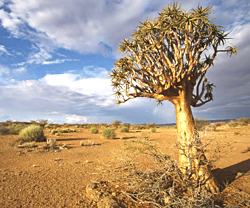DK Science: Habitats
A habitat is a place where plants and animals live, and provides them with food and shelter. It can be very small, such as a single tree or pond, or vast, such as a rainforest or desert. The physical conditions in a place and its vegetation are both part of the habitat. HABITAT LOSS is occurring in many parts of the world.

Tropical rainforests, such as the Amazon rainforest in South America, flourish in equatorial regions where it is hot all year round and it rains almost every day. A rainforest contains three main habitats: the upper layers of the trees, called the canopy; the darker, cooler understorey; and the forest floor. A greater variety of species live here than in any other habitat.

This quiver tree, in South Africa’s Northern Cape, is adapted to survive its desert habitat by storing water in its stout trunk. Deserts are harsh, dry habitats, with sometimes no rain for years. Animals and plants that live there have to cope with daytime temperatures of up to 50°C (120°F) and nights that can be very cold.
Habitat loss is the destruction of habitats such as forests and marshes through human activities, especially forestry and farming. Many species of animals and plants live in one small habitat and cannot survive anywhere else. It is estimated that more than a hundred species become extinct every day through habitat loss.
Cutting down natural forests (rather than forestry plantations) is called deforestation. The world’s tropical rainforests have suffered most from serious deforestation. The trees are cut down for their valuable timber, or burned to make space for farming and ranching. Across the world, an area of rainforest larger than the city of New York is cut down every day.
